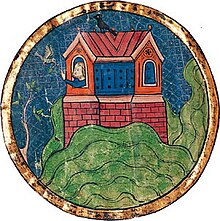Արարատի լեռներ
Արարատի լեռներ (աստվածաշնչյան եբրայրերն՝ הָרֵי אֲרָרָט, Սեպտուագինտա՝ τὰ ὄρη τὰ Ἀραράτ), տերմին, որն օգտագործվում է Ծննդոց գրքում, որպեսզի նշի այն վայրը, որտեղ Նոյը կանգ է առել Մեծ ջրհեղեղից հետո[1]։ Այդ տարածքը համապատասխանում է Ուրարտուին՝ Վանի թագավորություն։

Միջին դարերից սկսած՝ «Արարատի լեռները» սկսել են նույնացվել Արևմտյան Հայաստանի հայտնի Մասիս լեռան հետ, որը հայտնի է դարձել Արարատ լեռ անունով[2][3]։
Պատմություն
խմբագրելՄեջբերելով Բերոսոսին, Հիերոնիմոս Եգիպտացուն, Մնասեյին, Նիկողայոս Դամասկոսցուն՝ Հովսեփոս Փլավիոսը իր «Հրեաների հնությունները» գրքում գրում է․ «տապանը կանգ է առնում Հայաստանի մի լեռան գագաթին ... Մինյասի վրա, որը կոչվում էր Բարիս»[4]։
Նույն կերպ Լատինական Վուլգատայի մեջ Հիերոնիմոսը Ծննդոց 8:4-ը թարգամանում է հետևյալ կերպ․ «Եվ տապանը կանգ առավ... Հայաստանի լեռներում»[5], սակայն Վատիկանի երկրորդ ժողովից հետո հրապարակված Նոր Վուլգատայում տեղանունը փոխվել է «montes Ararat»-ով («Արարատի լեռներ»)[6]։
Ընդհակառակը, վաղ սիրիական և արևելյան ավանդույթը նշում է, որ տապանը կանգ է առել Ջուդի լեռան վրա, որն այսօր գտնվում է Շըրնաքի մարզում՝ Հարավարևելյան Անատոլիայում[7]․ այս զուգորդումն անհետացել է միջնադարում և այժմ սահմանափակվում է միայն որպես ղուրանական ավանդույթ հանդես գալով։
«Յուբիլևի գրքում» նշվում է, որ տապանը կանգ է առել Արարատ լեռան Լյուբարի անվամբ գագաթին[8]։
Սըր Ուոլթեր Ռելին իր «Աշխարհի պատմության» (1614) մի քանի գլուխ է նվիրել այն պնդմանը, որ հին ժամանակներում Արարատյան լեռներ տերմինը վերաբերել է ոչ միայն հայկական լեռներին, այլ նաև ավելի բարձր լեռնային լեռնաշղթաներին, որոնք ձգվում են դեպի Ասիա։ Նա պնդում է, որ քանի որ Հայաստանն իրականում չի գտնվում Շինարից դեպի արևելք[9][10][11][12][13], տապանը պետք է ինչ-որ տեղ վայրէջք կատարեր Արևելքում։
Տես նաև
խմբագրելԾանոթագրություններ
խմբագրել- ↑ «Genesis 8:4». Bible Hub. Online Parallel Bible Project. Վերցված է 2018 թ․ հունիսի 8-ին.
- ↑ Alexander Agadjanian (2016 թ․ ապրիլի 15). Armenian Christianity Today: Identity Politics and Popular Practice. Routledge. էջ 14. ISBN 978-1-317-17857-6. «It is worth noting that, contrary to Armenian Apostolic Church discourse and popular knowledge, it was probably as late as the beginning of the second millennium AD when the localization of the biblical Mount Ararat was permanently moved from the highlands hemming upper Mesopotamia to Mount Masis in the heart of historical Armenian territory.»
- ↑ Petrosyan, Hamlet (2001). «The Sacred Mountain». In Levon Abrahamian and Nancy Sweezy (ed.). Armenian Folk Arts, Culture, and Identity. Indiana University Press. էջ 36. ISBN 978-0-253-33704-7. «When Armenians were first introduced to the biblical story of the flood, there was no special interest in the location of Mount Ararat. Most Armenian historians in the Early Middle Ages accepted the generally held Christian opinion of the time that Ararat was located near Mesopotamia in Korduk (Corduene), the southernmost province of Armenia. However, when European Crusaders on their way to free the Holy Land from Moslem rule appeared in the region in the 11th century, Armenian hopes for similar "salvation" helped to catalyze the final identification of Masis with Ararat. From the 12th century on, Catholic missionaries and other travelers to the region returned to Europe with the same story: that the mountain where the Ark landed was towering in the heart of Armenia.»
- ↑ Կաղապար:PACEJ
- ↑ «The Book of Genesis: Chapter 8». LatinVulgate.com. Mental Systems, Inc. Վերցված է 2018 թ․ հունիսի 8-ին.
- ↑ «Liber Genesis». Nova Vulgata: Bibliorum Sacrorum Editio. The Holy See. Վերցված է 2018 թ․ հունիսի 8-ին.
- ↑ Conybeare, Frederick Cornwallis (April 1901). «Reviewed Work: Ararat und Masis. Studien zur armenischen Altertumskunde und Litteratur by Friedrich Murad». The American Journal of Theology. 5 (2): 335–337. doi:10.1086/477703. JSTOR 3152410.
- ↑ «The Book of Jubilees: Chapter 7». Pseudepigrapha, Apocrypha and Sacred Writings. Վերցված է 2018 թ․ հունիսի 8-ին.
- ↑ «Bereishit (Genesis) 11 :: Septuagint (LXX)». Blue Letter Bible. Blue Letter Bible. Վերցված է 2018 թ․ հունիսի 20-ին.
- ↑ «Genesis 11:2». Bible Hub. Online Parallel Bible Project. Վերցված է 2018 թ․ հունիսի 20-ին.
- ↑ «Commentaries: Genesis 11:2». Bible Hub. Online Parallel Bible Project. Վերցված է 2018 թ․ հունիսի 20-ին.
- ↑ Kolatch, Yonatan (2006). Masters of the Word: Traditional Jewish Bible Commentary from the First Through Tenth Centuries, Volume 1. Jersey City, New Jersey: KTAV Publishing House, Inc. էջ 214. ISBN 0-88125-936-5. Վերցված է 2018 թ․ հունիսի 20-ին.
- ↑ «Noah's Ark: The Ark of Noah in Iran?». BASE Institute. The Bible Archaeology, Search & Exploration (BASE) Institute. Արխիվացված է օրիգինալից 2018 թ․ հունիսի 20-ին. Վերցված է 2018 թ․ հունիսի 20-ին.